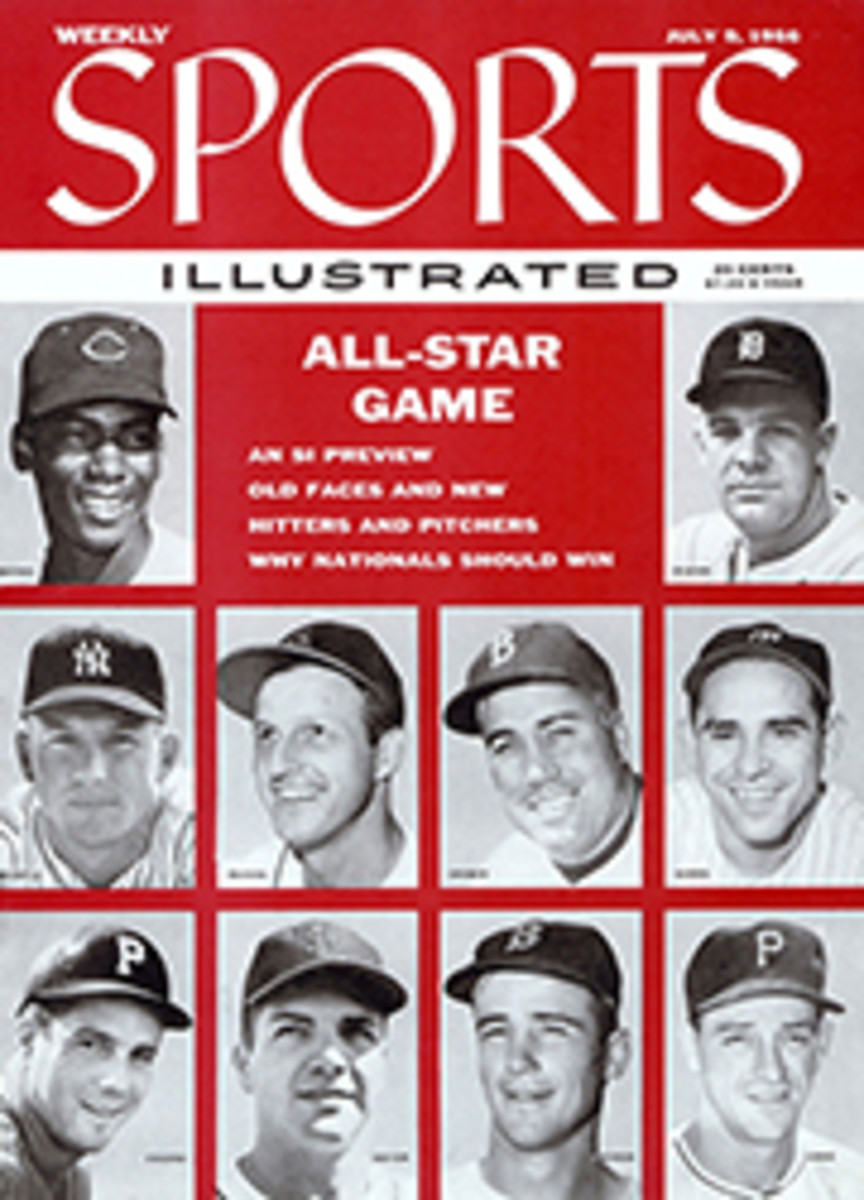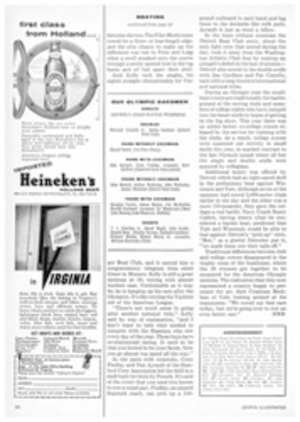
Britain, says the expert of London's 'Sunday Times,' reacted with one voice to our Canada Cup victory: HOORAY FOR HOGAN
WENTWORTH, ENGLAND
The tournament for the Canada Cup, departing from North America for the first time in its five years of existence, was by every standard a resounding success. Tens of thousands saw Hogan for the first and presumably last time in their lives, the sun blazed down on the Wentworth course for three successive days and the right team won. Almost the only person who had cause to remember the occasion with mixed feelings was the man who had his head cut open with a high slice of Sam Snead's—one of a good many, incidentally.
The occasion was indisputably made by Ben Hogan. In sophisticated areas around London, people fight shy of watching golf in large herds. "Probably a most frightful mob," they say—and stay away. This was something different. Whatever it cost them in blood, toil, sweat and sheer exhaustion, they were going to see this man play, if only for the fact that otherwise they would for years to come be at the mercy of beady-eyed bores pinning them down in a corner with "What? You never saw Hogan? My dear fellow, let me tell you...."
There was another, more warmly human, side to it. Hogan's story is as familiar in this country as in the States. People knew quite well that he would have exhausted himself in the U.S. Open eight days previous and that the Canada Cup with two rounds on the final day would be a grueling physical experience. They knew that there was no possible need, moral or financial, for him to subject himself to these rigors. When he chose to do so they took him genuinely to their hearts. Rarely since the days of Bobby Jones can a man have been followed by so many people wishing him so sincerely well, and I believe that beneath the inscrutable mask he was really touched by the warmth of his welcome. In return he put on for his 10,000-strong reception committee the show of a lifetime.
The west course at Wentworth at its full stretch of nearly 7,000 yards is at any time a tough proposition. I do not know who first christened it the Burma Road, but by this name it is known among the professionals, although a school of thought prevailed before the contest that the appellation ought to be played down for fear of offending the Japanese! In layout it resembles the best American country club courses like Pine Valley or Winged Foot but with tracts of tough heather between the fairways and the woods and of course the closer-cropped turf and faster greens characteristic of golf in Britain. It was the scene of the 1953 Ryder Cup match, which Britain failed to win only by a couple of five-foot putts.
This year's Canada Cup contest was the first public golfing event to be played on the Sabbath. If Lord Cow-dray in his ancestral park could charge people 10 shillings to watch the Duke of Edinburgh play polo on a Sunday afternoon, it was held, why should not the public be permitted to pay the same to watch the representatives of 29 nations assembled for the purpose of international good will? The normally troublesome Lord's Day Observance Society held its peace, and all was well. Long before midday the people were rolling up in thousands.
One man at the gate sold single-handed 1,900 copies of the program—a lavish affair of which five tons had been printed in Switzerland, flown by two chartered Dakotas and conveyed to Wentworth by truck from an airport on the other side of London.
Inevitably, almost the entire crowd attached itself to a quartet which contained not only Hogan but, for good measure, the copybook stylist Sam Snead; the man who beat him when he collapsed from four up with six to play in the Ryder Cup, Harry Weetman; and finally, England's most successful player of the previous year, Ken Bousfield. And I must tell you of Hogan's opening impact on his first English gallery. The first hole at Went-worth is 470 yards long and generally requires two wooden shots. Hogan was just over the back in 2. Now doubtless we should be seeing that mastery of the short game for which Americans are so celebrated on this side. We did. He chipped it in for a 3.
The second, 156 yards, is across a valley to a plateau green. Ben's 12-foot putt rolled in for a 2. The third, 444 yards, is all uphill to a terraced green, for nine months of the year unreachable in 2, and Ben took 4. The fourth, 505 yards, goes round a corner of the woods and downhill to the distant green. Ben reached the short edge in 2—and holed it for a three. After this a 3 at the short fifth was a mere formality.
So now, having arrived with a bigger buildup than any man before him and carrying with him this huge and highly personal gallery, he had played five holes in England and his total was 15 (3-2-4-3-3), or level 3. His putt went in and out of the seventh, he was out in 31 and holed a six-yarder for a 2 at the 10th—his average for 10 holes having now risen to 3.3. He fell from grace with a 6 at the 11th, but never mind. Was it true what they said about Hogan? It was indeed! In the meantime his partner Sam Snead was having a rough time of it. We all like to see great players miss them occasionally—it bolsters up our egos—but it was uncomfortable to see a man as great as this as bad as this. For Sam all was to come right in the end, but no one knew it then. He got round in 76. A lesser man would have been 82.
Australia led the first round, aided by a 68 from Peter Thomson, who has won our Open twice and is one day, mark my words, going to win yours. One stroke behind were Wales and Mexico, with 69s from Smalldon and De Vicenzo, and one more stroke behind were the United States and Canada (Balding 75, Leonard 69). As we were soon to realize, with four players counting every shot for four rounds, a lead of even half a dozen strokes can vanish in as many minutes. In the second round Leonard's 67 and Balding's 72 gave Canada a three-shot lead over America (Hogan 69, Snead 73), with Wales trailing by two more shots.
For various reasons it was necessary to play two rounds on the final day. Amateur mathematicians worked out that at the current rate of progress, about five hours per round, the last of the 56 players would come in around 10:30 at night. There was only one thing for it, to qualify the first 20 nations. The other nine, in fact, played a one-round consolation tournament, won by New Zealand.
Three rounds saw Canada (428) still three ahead of the U.S. (431), with South Africa (435), Wales, Mexico, Belgium (445) and Australia trailing (456). It was blazing hot now and the shirtsleeved crowd, seen from the top of the 70-foot television tower, was indistinguishable from a similar crowd in America. The marshaling, however, was efficient, and I pass on Went-worth's secret. Various London clubs volunteer to marshal one hole apiece. The volunteers come in free, and the team which is adjudged to have done the best job gets a case of Scotch. (Passed to the USGA for information.)
SNEAD RECOVERS
Any who thought that Hogan could not stand the strain of nearly 11 hours of golf were at once disabused of this notion. A start of 4-3-4 was almost automatic by now, but the fourth looked like giving trouble. He was bunkered in 2—but then, as he says in his book, "Bunker shots are easy." I suppose they are. At any rate, this one went in for a 3. Meantime Snead, "swinging slower and slower," as Leonard Crawley put it, "as if to hit it farther and farther," had come back into his own. His 4-3-4-4-3 together with Hogan's 4-3-4-3-3, matched against Bal-ding's 4-3-4-4-4 and Leonard's 5-5-5-4-3, turned 6 shots in America's favor in five holes, and the process went remorselessly on till in the end the Canadians were 16 shots behind and ousted for second place by South Africa. Snead finished in a minor blaze of glory to make up for his previous troubles with 3-4-3-4-4, only one of these being a short hole and the last two measuring well over 500 yards. Both the Americans finished in 68, and the cheers that greeted Hogan's final putt should ring in his ears till the end of his days.
We welcomed this Canada Cup with open arms in Britain and were not disappointed. As Lord Brabazon wrote: "It is rather like an eclipse. If it occurs in your country, you should not miss it, for you will never see it again." Nevertheless, we hope that one day we shall.
PHOTO
EXPLOSION OF SAND MARKS THE BALL'S FLIGHT AS ALL-CONQUERING HOGAN HITS OUT OF FIFTH FAIRWAY BUNKER DURING THE FINAL DAY

